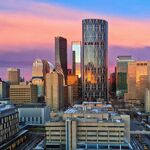Tarsus
Active Member
I wouldn’t be surprised to see more of Mission added to the downtown boundaries.Amazing to see the population go from 38k to around 68k in only 10 years! None of the other midsize metros have seen anything close to that kind of growth in their downtowns. And they all have larger areas. If Calgary added two or three extra square kilometers we’d be easily over 70k.
Maybe not the next census, but I would also expect to see some of lower mount royal added as well.










